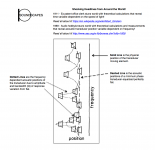Not worrying about all the other stuff, if you can see the diaphragm through the front of the mic (not familiar with the mic in question), you can put it under a microscope with a dial indicator mounted to the focus and measure the relative position of the surfaces. Easily possible to measure distances with a resolution of 0.02 mm or less. Much less with more mag and a stable setup.
...However there is a part of uncertainty, from 2 to 5 mm, for the exact location of the cell of the measuring microphone : what is its distance from the mike front ?
Just for fun I'm going to ruin everything! 🙂
Actually, Demian already did this and the OP already knew this, but the following is probably going to be helpful to some.
To know the exact acoustic position of a transducer, you'd have to specify the frequency, bandwidth and absolute phase of both the transmitting and receiving transducers in the measurement setup.
Measuring the physical position of the transducer is easy unless you've misplaced it. 🙂
Happily, we only need to know the relative distances between the loudspeaker drivers and measurement microphone for alignment purposes. Thus it is always best to use the same mic at the same location during the same measurement session when recording arrival time differences between drivers.

Download: View attachment Heyser.pdf
How to Remove Time of Flight from a Measurement
Last edited:
- Status
- Not open for further replies.